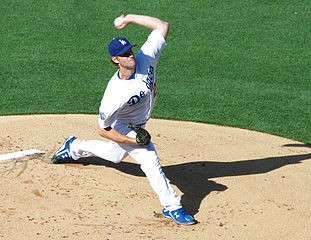Clayton Kershaw won the NL MVP last year. There are many who feel that a pitcher should not be eligible for the MVP, since they only play in about 32 games and position players play in as many as 162.
What they are implying is that a position player is not merely playing in every game, but helping his team win every game.
Is this really true, though? Let’s use AL MVP Mike Trout as an example. Trout is one of my favorite players, so this is definitely not an indictment of Trout.
Trouticus Maximus played in 157 games in 2014. Let’s go to his Baseball Reference page and look at his game logs for 2014. Let’s focus on a column near the right that is labeled WPA. This is “win probability added” – a sum of all the things a hitter or pitcher did to help (or hurt) his team, expressed as a decimal. In a nutshell, each game starts with a 50% win probability for each team and the actions of all the players cause this to rise to 100% for one team and to drop to 0% for the other team. Hit a homer, you get credit. Strike out with the bases loaded and you get docked.
Let’s sort on the WPA field. We find that Mike Trout – the AL MVP and arguably the very best player in baseball – had a WPA of .000 or worse in 70 of the 157 games in which he played. In those 70 games (44.6% of games), Mike Trout’s performance hurt the Angels. OK, I’ll admit that he only lowered the win probability by 10%+ in 9 games. But it’s also true that he only raised the WPA by 10%+ in 43 games (27.4%). That’s the point – in the vast majority of games, position players don’t move the needle very much. They’ll go one for four with a single, get stranded on first, and make a couple of routine plays in the field.
Clayton Kershaw played in only 27 games. Looking at his 2014 game logs, he hurt his team’s chances of winning in 6 of those games (22.2%). His median WPA was 21%, meaning that he moved the needle from a neutral 50% chance to 71% by his performance alone. Mike Trout’s median WPA was 2.1%,
What does this mean? It means that “played X games” is not a good measure of a player’s contributions. By the very nature of the game, a starting pitcher has a larger role in the outcome of the game. In a typical game, a pitcher will exert himself far more than a position player, throwing 100+ pitches and needing to ice down his arm after the game. Even the most active position players don’t put the same amount of strain on their body.
It’s important to note both the frequency and intensity of a player’s impact.
Photo credit: User kla4067 on Flickr
Next post: The Ben Zobrist Trade, from the A’s SidePrevious post: What Bat Speed Really Does for Hitters





Eddy Wahlgren
Well stated and I agree wholeheartedly, the pitcher has a great effect on the game in his more limited innings.That being said I feel like the pitcher should have an overwhelmingly dominant season, like Kershaw had, to win the MVP.